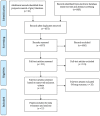Child Domestic Work, Violence, and Health Outcomes: A Rapid Systematic Review
- PMID: 35010705
- PMCID: PMC8744913
- DOI: 10.3390/ijerph19010427
Child Domestic Work, Violence, and Health Outcomes: A Rapid Systematic Review
Abstract
This rapid systematic review describes violence and health outcomes among child domestic workers (CDWs) taken from 17 studies conducted in low- and middle-income countries. Our analysis estimated the median reported rates of violence in CDWs aged 5-17-year-olds to be 56.2% (emotional; range: 13-92%), 18.9% (physical; range: 1.7-71.4%), and 2.2% (sexual; range: 0-62%). Both boys and girls reported emotional abuse and sexual violence with emotional abuse being the most common. In Ethiopia and India, violence was associated with severe physical injuries and sexual insecurity among a third to half of CDWs. CDWs in India and Togo reported lower levels of psycho-social well-being than controls. In India, physical punishment was correlated with poor psycho-social well-being of CDWs [OR: 3.6; 95% CI: 3.2-4; p < 0.0001]. Across the studies, between 7% and 68% of CDWs reported work-related illness and injuries, and one third to half had received no medical treatment. On average, children worked between 9 and 15 h per day with no rest days. Findings highlight that many CDWs are exposed to abuse and other health hazards but that conditions vary substantially by context. Because of the often-hidden nature of child domestic work, future initiatives will need to be specifically designed to reach children in private households. Young workers will also benefit from strategies to change social norms around the value and vulnerability of children in domestic work and the long-term implications of harm during childhood.
Keywords: child domestic worker; health; low-income countries; middle-income countries; violence.
Conflict of interest statement
The authors declare no conflict of interest. The funder had no role in the design of the study; in the collection, analyses, or interpretation of data; in the writing of the manuscript, or in the decision to publish the results.
Figures
References
-
- Unicef Child Labour and Exploitation. [(accessed on 8 August 2021)]. Available online: https://www.unicef.org/rosa/what-we-do/child-protection/child-labour-and....
-
- International Labour Organization . Hazardous Child Domestic Work: A Briefing Sheet. ILO; Geneva, Switzerland: 2007.
-
- Pocock N.S. Child Domestic Worker Prevalence in Myanmar and Southeast Asia: Briefing Note. London School of Hygiene and Tropical Medicine; London, UK: 2019.
Publication types
MeSH terms
LinkOut - more resources
Full Text Sources
Medical


